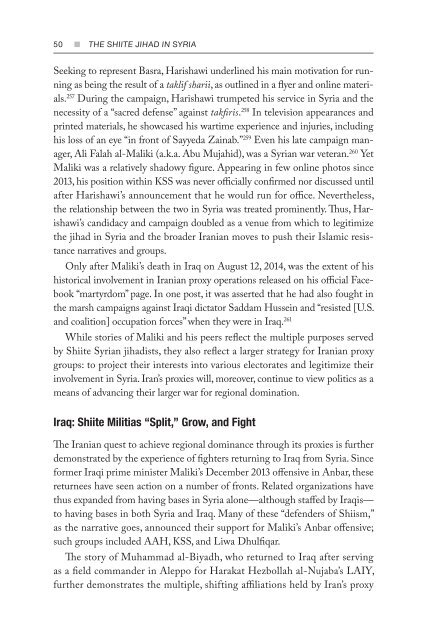You also want an ePaper? Increase the reach of your titles
YUMPU automatically turns print PDFs into web optimized ePapers that Google loves.
50 n <strong>THE</strong> <strong>SHIITE</strong> <strong>JIHAD</strong> <strong>IN</strong> <strong>SYRIA</strong><br />
Seeking to represent Basra, Harishawi underlined his main motivation for running<br />
as being the result of a taklif sharii, as outlined in a flyer and online materials.<br />
257 During the campaign, Harishawi trumpeted his service in Syria and the<br />
necessity of a “sacred defense” against takfiris. 258 In television appearances and<br />
printed materials, he showcased his wartime experience and injuries, including<br />
his loss of an eye “in front of Sayyeda Zainab.” 259 Even his late campaign manager,<br />
Ali Falah al-Maliki (a.k.a. Abu Mujahid), was a Syrian war veteran. 260 Yet<br />
Maliki was a relatively shadowy figure. Appearing in few online photos since<br />
2013, his position within KSS was never officially confirmed nor discussed until<br />
after Harishawi’s announcement that he would run for office. Nevertheless,<br />
the relationship between the two in Syria was treated prominently. Thus, Harishawi’s<br />
candidacy and campaign doubled as a venue from which to legitimize<br />
the jihad in Syria and the broader Iranian moves to push their Islamic resistance<br />
narratives and groups.<br />
Only after Maliki’s death in Iraq on August 12, 2014, was the extent of his<br />
historical involvement in Iranian proxy operations released on his official Facebook<br />
“martyrdom” page. In one post, it was asserted that he had also fought in<br />
the marsh campaigns against Iraqi dictator Saddam Hussein and “resisted [U.S.<br />
and coalition] occupation forces” when they were in Iraq. 261<br />
While stories of Maliki and his peers reflect the multiple purposes served<br />
by Shiite Syrian jihadists, they also reflect a larger strategy for Iranian proxy<br />
groups: to project their interests into various electorates and legitimize their<br />
involvement in Syria. Iran’s proxies will, moreover, continue to view politics as a<br />
means of advancing their larger war for regional domination.<br />
Iraq: Shiite Militias “Split,” Grow, and Fight<br />
The Iranian quest to achieve regional dominance through its proxies is further<br />
demonstrated by the experience of fighters returning to Iraq from Syria. Since<br />
former Iraqi prime minister Maliki’s December 2013 offensive in Anbar, these<br />
returnees have seen action on a number of fronts. Related organizations have<br />
thus expanded from having bases in Syria alone—although staffed by Iraqis—<br />
to having bases in both Syria and Iraq. Many of these “defenders of Shiism,”<br />
as the narrative goes, announced their support for Maliki’s Anbar offensive;<br />
such groups included AAH, KSS, and Liwa Dhulfiqar.<br />
The story of Muhammad al-Biyadh, who returned to Iraq after serving<br />
as a field commander in Aleppo for Harakat Hezbollah al-Nujaba’s LAIY,<br />
further demonstrates the multiple, shifting affiliations held by Iran’s proxy


